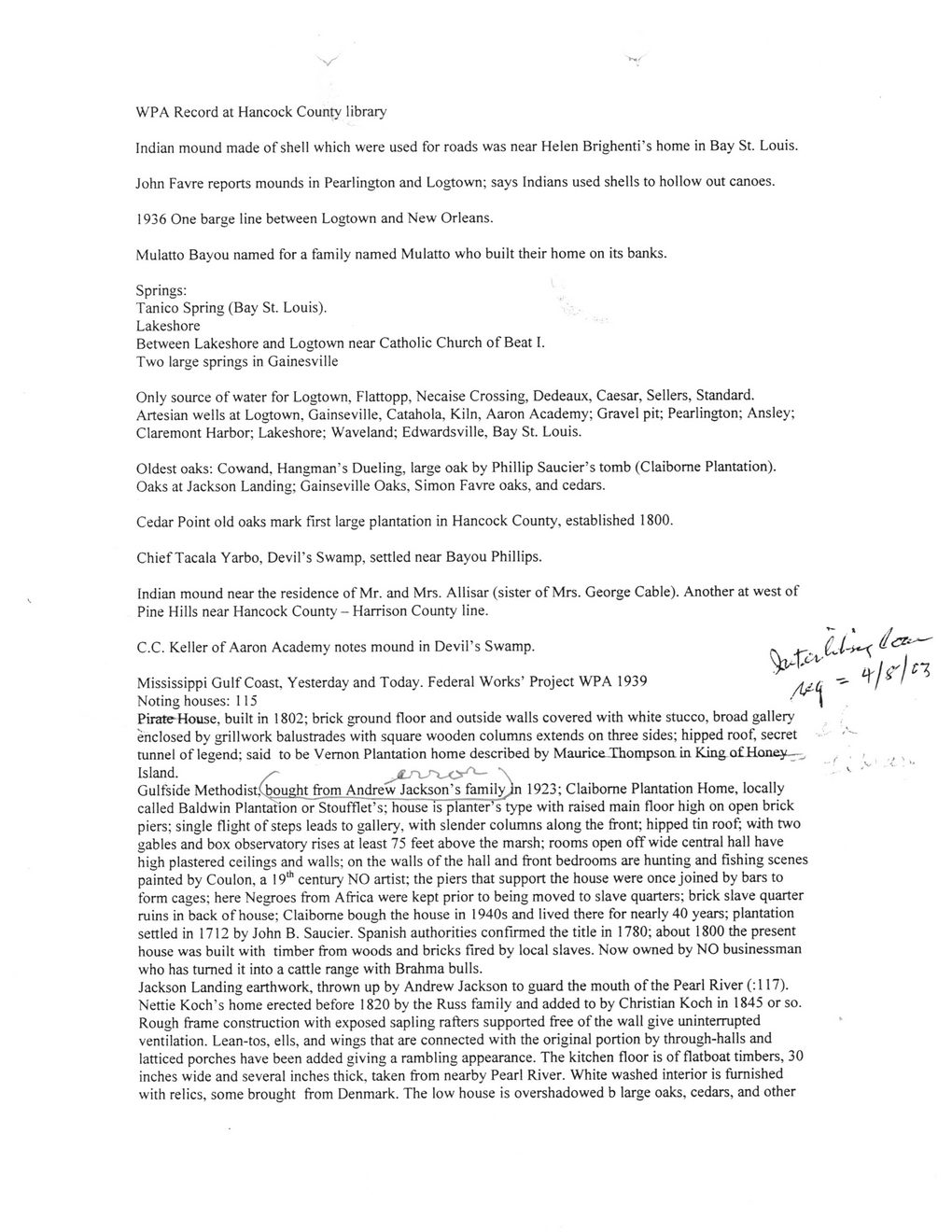This text was obtained via automated optical character recognition.
It has not been edited and may therefore contain several errors.
V" WPA Record at Hancock County library Indian mound made of shell which were used for roads was near Helen Brighenti’s home in Bay St. Louis. John Favre reports mounds in Peariington and Logtown; says Indians used shells to hollow out canoes. 1936 One barge line between Logtown and New Orleans. Mulatto Bayou named for a family named Mulatto who built their home on its banks. Springs: Tanico Spring (Bay St. Louis). Lakeshore Between Lakeshore and Logtown near Catholic Church of Beat I. Two large springs in Gainesville Only source of water for Logtown, Flattopp, Necaise Crossing, Dedeaux, Caesar, Sellers, Standard. Artesian wells at Logtown, Gainseville, Catahola, Kiln, Aaron Academy; Gravel pit; Peariington; Ansley; Claremont Harbor; Lakeshore; Waveland; Edwardsville, Bay St. Louis. Oldest oaks: Cowand. Hangman’s Dueling, large oak by Phillip Saucier’s tomb (Claiborne Plantation). Oaks at Jackson Landing; Gainseville Oaks, Simon Favre oaks, and cedars. Cedar Point old oaks mark first large plantation in Hancock County, established 1800. Chief Tacala Yarbo, Devil’s Swamp, settled near Bayou Phillips. Indian mound near the residence of Mr. and Mrs. Allisar (sister of Mrs. George Cable). Another at west of Pine Hills near Hancock County - Harrison County line. C.C. Keller of Aaron Academy notes mound in Devil’s Swamp. v^1 Mississippi Gulf Coast, Yesterday and Today. Federal Works’ Project WPA 1939 > , Noting houses: 115 Pirate House, built in 1802; brick ground floor and outside walls covered with white stucco, broad gallery enclosed by grillwork balustrades with square wooden columns extends on three sides; hipped roof, secret tunnel of legend; said to be Vemon Plantation home described by Maurice Thompson, in King of Honey Island. \ Gulfside Methodist.Cbought from Andrew Jackson’s familyjn 1923; Claiborne Plantation Home, locally called Baldwin Plantation or Stoufflet’s; house is planter s type with raised main floor high on open brick piers; single flight of steps leads to gallery, with slender columns along the front; hipped tin roof; with two gables and box observatory rises at least 75 feet above the marsh; rooms open off wide central hall have high plastered ceilings and walls; on the walls of the hall and front bedrooms are hunting and fishing scenes painted by Coulon, a 19th century NO artist; the piers that support the house were once joined by bars to form cages; here Negroes from Africa were kept prior to being moved to slave quarters; brick slave quarter ruins in back of house; Claiborne bough the house in 1940s and lived there for nearly 40 years; plantation settled in 1712 by John B. Saucier. Spanish authorities confirmed the title in 1780; about 1800 the present house was built with timber from woods and bricks fired by local slaves. Now owned by NO businessman who has turned it into a cattle range with Brahma bulls. Jackson Landing earthwork, thrown up by Andrew Jackson to guard the mouth of the Pearl River (: 117). Nettie Koch’s home erected before 1820 by the Russ family and added to by Christian Koch in 1845 or so. Rough frame construction with exposed sapling rafters supported free of the wall give uninterrupted ventilation. Lean-tos, ells, and wings that are connected with the original portion by through-halls and latticed porches have been added giving a rambling appearance. The kitchen floor is of flatboat timbers, 30 inches wide and several inches thick, taken from nearby Pearl River. White washed interior is furnished with relics, some brought from Denmark. The low house is overshadowed b large oaks, cedars, and other ’ -/r/n

Pirate House Document (108)